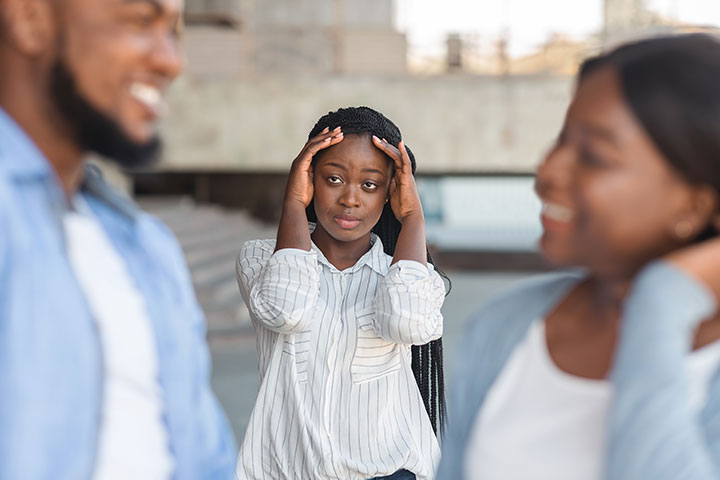
Closeness. A single word with countless definitions and dimensions. Most generally, closeness refers to the degree of interdependence between partners in a relationship.1 This widely used definition of closeness includes four dimensions: strength, how powerfully one partner influences the other, frequency, the amount of time spent interacting with each other, diversity, the range of different life domains in which one partner influences the decisions and behaviors of the other, and duration of influence, the idea that the longer two people are interdependent, the closer they will be.2 Closeness, like many things, is complicated. One size does not, in fact, fit all.3 However, many relationship behaviors can be predicted based on this interdependence model, including when partners are most likely to be jealous.
A general assumption that the closer two people are, the less jealousy there is within the relationship. But jealousy is another complicated, multi-faceted term.
Jealousy is more often than not seen as bad, as a socially undesirable emotion, associated with low self- confidence, loneliness, and insecurity. However, jealousy CAN be seen as good, as a sign of greater love and associated with being more in-love. You may be wondering which definition of jealousy is correct. Again, it’s complicated. In theory, both definitions of jealousy are correct, at least when referencing Bringle’s transactional model of jealousy. This model specifies that there are two types of jealousy, one that is bad and the other that is… good? Let’s start with the bad.
“Bad” jealousy is probably what you often think of when you think of the word jealousy. “Bad” jealousy, according to Bringle’s model, can also be referred to as the suspicious type of jealousy. This type is associated with the classic signs of jealousy: high levels of anxiety, doubt, suspiciousness, personal insecurity, and insecurity about the relationship.4 This type of jealousy is often completely unnecessary and experienced in the absence of any major jealousy- evoking events. Now, the “good?” jealousy or the emotional or reactive type of jealousy. This type is essentially a direct response to the discovery of actual events that threaten the stability of the relationship, such as flirting.
Now that I’ve attempted to define closeness and jealousy, let’s take a closer look at how they interact. According to Attridge (2013), greater relationship closeness is positively correlated with the “good” type of jealousy, and is negatively associated with the “bad” type of jealousy. This finding suggests that the more that the relationship partner was considered to be important to the person, the more that person was ready to react with jealousy. This research also indicated that couples that spend more time together (or are physically closer) are less suspicious about their partner’s fidelity whereas couples who spend time together more infrequently were associated with a suspicious form of jealousy.5 Researchers have also found that since healthy relationships predict physical and psychological well-being, protecting these bonds is extremely important and may even be innately programmed within humans.6 Jealousy, when it is reactive, is therefore somewhat inevitable, so don’t fret it!
- Mark Attridge, “Jealousy and Relationship Closeness,” SAGE Open 3, no. 1 (January 1, 2013): 215824401347605, https://doi.org/10.1177/2158244013476054. ↩︎
- Mark Attridge, “Jealousy and Relationship Closeness.” ↩︎
- Gary W. Lewandowski, The Science of Relationships: Answers to Your Questions about Dating, Marriage, and Family.(Dubuque, IA: Kendall Hunt Publishing Co., 2011), 55. ↩︎
- Mark Attridge, “Jealousy and Relationship Closeness.” ↩︎
- Mark Attridge, “Jealousy and Relationship Closeness.” ↩︎
- Geoff MacDonald and Mark R. Leary, “Why Does Social Exclusion Hurt? The Relationship between Social and Physical Pain.,” Psychological Bulletin 131, no. 2 (March 2005): 202–23, https://doi.org/10.1037/0033-2909.131.2.202. ↩︎
I really like this take on our focus on the role of closeness in relationships. I think jealousy is often discussed in the bad manner, as you mention throughout your blog, which leads to people associating it with insecurity and a lack of closeness. While that can be true with couples who spend less time together, it is also important to understand the nuances of jealousy to understand how it can appear in relationships.
I like how it highlighted that closeness isn’t a one-size-fits-all phenomenon but encompasses various dimensions like strength, frequency, diversity, and influence duration. Similarly, it sheds light on the nuanced nature of jealousy, distinguishing between the “bad” and “good” types and how they manifest in different scenarios. Also, the correlation between closeness and jealousy offers valuable insights into how these emotions interact within relationships.